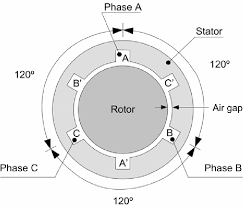An induction motor is called an asynchronous motor because the actual speed of the motor is not equal to the synchronous speed of the motor. The synchronous speed of the motor is always more than the actual speed of the motor. If the actual speed of the motor(N) is equal to the synchronous speed (Ns), then no torque will be produced, and the motoring function is not possible.

That is why an induction motor is called an asynchronous motor. Let us understand the synchronous speed of the motor. The synchronous speed is the speed of the rotating magnetic field, which is produced when the three-phase supply is fed to the stator of the motor. The rotor conductors of an induction motor are short-circuited at the end rings. The magnetic field acts on the rotor. When the magnetic field gets linked to the rotor conductors, the voltage is induced in the rotor conductors. The underlying principle is electromagnetic induction, similar to a transformer.
However, if the rotating magnetic field and rotor rotate at the same synchronous speed, the EMF induced in the rotor is zero because the field will be constant with respect to the rotor. The voltage will be induced in the rotor if a rate of change of flux exists.
The motor rotation happens when there is a slip between the rotor and the stator. The slip is the difference between the rotational magnetic field’s speed and the rotor’s actual speed. The inability of the rotor to catch the speed of the rotating magnetic field is called the motor’s slip. Thus, an induction motor working is possible if a slip exists between the rotating magnetic field and the actual speed of the rotor. As the load is increased on the motor, its slip gets increased.
That is why an induction motor is called an asynchronous motor.
1 thought on “Why Induction Motor is called Asynchronous Motor?”